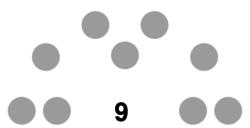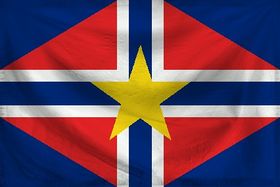Difference between revisions of "General Assembly (The Leftist Assembly)"
m (→Terms) |
|||
| Line 33: | Line 33: | ||
|- | |- | ||
| [[1st General Assembly|1st]] | | [[1st General Assembly|1st]] | ||
| − | | March 2016 | + | | [[The Leftist Assembly election, March 2016 | March 2016]] |
| Atealia | | Atealia | ||
|- | |- | ||
| Line 41: | Line 41: | ||
|- | |- | ||
| [[3rd General Assembly|3rd]] | | [[3rd General Assembly|3rd]] | ||
| − | | September 2016 | + | | [[The Leftist Assembly election, September 2016 | September 2016]] |
| Cedoria | | Cedoria | ||
|} | |} | ||
Revision as of 17:02, 26 December 2016
| General Assembly | |
|---|---|
| 3rd General Assembly | |
 | |
| Leadership | |
| Secretary | Cedoria |
| Prime Minister | Auven |
| Structure | |
| Seats | 9 |
 | |
The General Assembly is the legislative body for the government of The Leftist Assembly. It consists of nine members, and laws and amendments may be proposed by any member.
For a proposal to be ratified, it must undergo the formal legislative process before voting. This consists of creating an Act (including a description, any existing law being affected, and the alternative law being proposed), submitting it for General Assembly discussion, and then opening the discussion for public feedback. Following this, a vote may be held on the proposed legislation. For it to be passed in the General Assembly it must receive five votes with the endorsement of the Secretary or seven votes without the endorsement of the Secretary. For it to be passed by referendum it must receive a simple majority of the votes with the endorsement of the Secretary or two-thirds of the vote without the endorsement of the Secretary.
Each of the positions is elected through the alternative voting system. Terms last for 3 months and voting in elections begins at the end of the respective month (March, June, September, or December).
Contents
History
Party system
Upon its founding, the region functioned with a multi-party system. This system was complicated and details were often disputed between editors and interpreters. Essentially, candidates were nominated to different positions by their party. Once these were elected, an additional vote was held to determine the number of seats each party received out of the total 100 in the General Assembly. Rather than there being 100 individual nations each representing their party, each party would put forward a single stance on each legislation. For example, the 1st General Assembly required any two parties to vote for a piece of legislation to pass it. In late August 2016, the members of the region democratically chose to change the government to an independent system in the form of a 9-member council, as proposed by Llorens.
Terms
The General Assembly is in its 3rd term.
| Term | Election | Secretary |
|---|---|---|
| 1st | March 2016 | Atealia |
| 2nd | - | Atealia |
| 3rd | September 2016 | Cedoria |
Ministries
There are five ministries, in addition to the Secretary and Prime Minister, that are each headed by a Minister, except for the Ministry of Law, which has two Minor Justices and a Chief Justice. A new ministry can be formed or deactivated should the need arise with the approval of at least 60% of the General Assembly and an endorsement by the Secretary. The following are the nations that currently fill these positions:
| Ministry | Minister | ||
|---|---|---|---|
| Secretary | Cedoria | ||
| Prime Minister | Auven | ||
| Archives | Halfblakistan | ||
| Defence | Rare Pepe Hunters | ||
| Foreign Affairs | New Tuva SSR | ||
| Immigration and Customs | Daemynos | First Justice | Second Justice |
| Law | Llorens | Losinia | Celera |
Secretary
The roles and responsibilities of the Secretary of the Assembly:
- Serves as the head of the region for diplomacy and military action
- Calls for action against other regions
- Declares state of emergencies
- Appoints ministers that serve under them, Defence and Foreign Affairs
Prime Minister
The roles and responsibilities of the Prime Minister:
- Is the head of any non-appointed ministers
- Briefs the Secretary
- Becomes de-facto Secretary if current one resigns or is removed
Ministry of Archives
The roles and responsibilities of the Minister of Archives:
- Preserves and documents any major political or historical regional event
- Avoids bias in any records, and may face a Vote of No Confidence as a consequence
Ministry of Defence
The roles and responsibilities of the Minister of Defence:
- Handles the United Armed Forces of The Leftist Assembly
- Deals with foreign raider/defence incidents
- Proposes raids to Secretary for authorisation
- Authorises urgent defence of home and allied left-wing regions
Ministry of Foreign Affairs
The roles and responsibilities of the Minister of Foreign Affairs:
- Handles relations with allied and enemy regions
- Organises interregional communication and cooperation
- Establishes embassies
- Encourages peace talks
- Jointly authorises Declarations of War with Secretary
Ministry of Immigration and Customs
The roles and responsibilities of the Minister of Immigration and Customs:
- Recruits nations to the region
- Ensures newly joined nations are in accordance with the Constitution
- Notifies 'out-of-line' nations to correct any discrepancies
Ministry of Law
The roles and responsibilities of the Minister of Law:
- Is the head of the region's judicial body
- Determines laws or amendments as constitutional or not
- Can be cancelled out by joint decision of Minor Justices
- Is replaced by First Minor Justice if removed or resigned, and Second Minor Justice following that
| ||||||||||||||||||||||||||||||||||||||||||||||||


